History and exam
Key diagnostic factors
common
insidious onset
Patients may complain of insidious onset for patellar, quadriceps, and Achilles tendinopathies.
well-localized tenderness
Palpation of the affected tendon reproduces the pain.[Figure caption and citation for the preceding image starts]: Test for medial epicondylitis: resisted forearm pronation and palmar flexion elicits pain at the medial epicondyleFrom the personal collection of James Wang, PhD [Citation ends].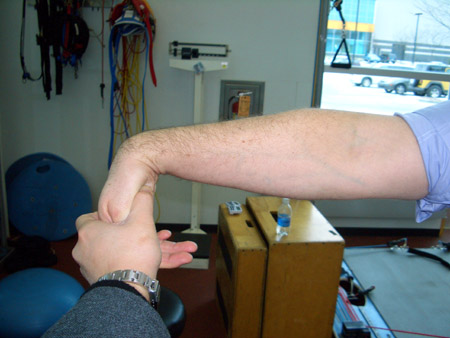 [Figure caption and citation for the preceding image starts]: Test for lateral epicondylitis: resisted wrist extension with elbow in full extension stresses the origin of the extensor carpi radialis brevis tendon and elicits pain at the lateral epicondyleFrom the personal collection of James Wang, PhD [Citation ends].
[Figure caption and citation for the preceding image starts]: Test for lateral epicondylitis: resisted wrist extension with elbow in full extension stresses the origin of the extensor carpi radialis brevis tendon and elicits pain at the lateral epicondyleFrom the personal collection of James Wang, PhD [Citation ends].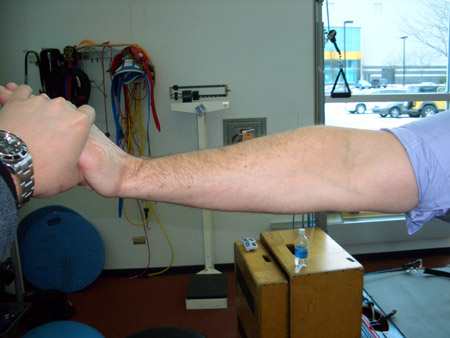 [Figure caption and citation for the preceding image starts]: Medial and lateral pressure applied anterior and superior to the Achilles insertion elicits painFrom the personal collection of James Wang, PhD [Citation ends].
[Figure caption and citation for the preceding image starts]: Medial and lateral pressure applied anterior and superior to the Achilles insertion elicits painFrom the personal collection of James Wang, PhD [Citation ends].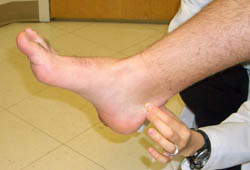 [Figure caption and citation for the preceding image starts]: Impingement test: with shoulder in 90º forward flexion, elbow in 90º flexion, apply downward pressure on the hand while stabilizing at the elbow. Pain = positive testFrom the personal collection of James Wang, PhD [Citation ends].
[Figure caption and citation for the preceding image starts]: Impingement test: with shoulder in 90º forward flexion, elbow in 90º flexion, apply downward pressure on the hand while stabilizing at the elbow. Pain = positive testFrom the personal collection of James Wang, PhD [Citation ends].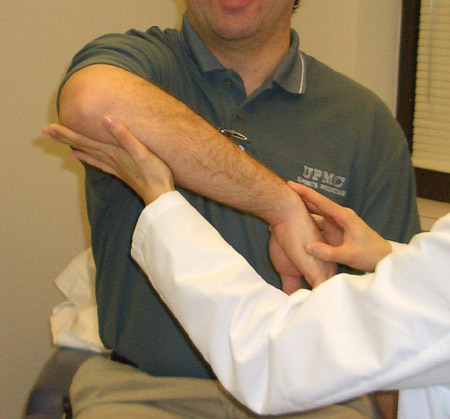 [Figure caption and citation for the preceding image starts]: Impingement test: with hand in full pronation, passively raise shoulder in line of movement of scapula. Pain = positive testFrom the personal collection of James Wang, PhD [Citation ends].
[Figure caption and citation for the preceding image starts]: Impingement test: with hand in full pronation, passively raise shoulder in line of movement of scapula. Pain = positive testFrom the personal collection of James Wang, PhD [Citation ends].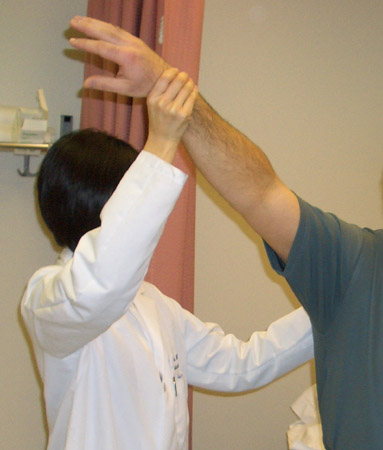
Other diagnostic factors
common
pain during activity
In early stages, pain occurs at the onset of activity, but may resolve after a warm-up period. In later stages, pain may persist as a dull ache after activity.
uncommon
tendon thickening
Found in the later phase of tendinopathy.
tendon nodularity
Found in the later phase of tendinopathy.
crepitus
Usually only seen in the acute phase of Achilles tendinopathy.
Risk factors
strong
athletic training
This is one of the most common risk factors. Because tendinopathy is mainly an overuse injury to the muscle-tendon units, adequate periods of rest are required to allow appropriate healing. When rest periods are insufficient, impaired tendon healing leads to pain.[21][22]
Poor athletic training technique, poor flexibility, imbalance in muscle use and training, or poor cardiovascular conditioning may increase risk for overuse.[21][22] Previous tendon or muscle injury may also predispose to reinjury in subsequent training.[21][22]
unsuitable equipment
Contributes to overuse and strain.[22]
hard and high-friction playing surface
Contributes to overuse and strain.[22]
weak
increasing age
fluoroquinolone treatment
Some evidence suggests an increased risk of tendinopathy in people taking fluoroquinolones.[26] However, the general healthy population treated with fluoroquinolones is at low risk for tendinopathy.
Fluoroquinolones are not recommended as first-line antibiotics due to their potential adverse effect profile. The most commonly affected tendon is the Achilles tendon, but other tendons, including those of the shoulder and hand, may be affected. Likelihood increases with age >60 years, renal insufficiency, and corticosteroid use.[26][27][28][29]
Use of this content is subject to our disclaimer